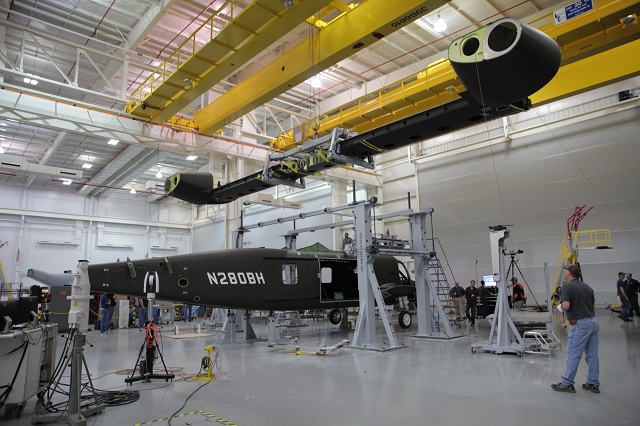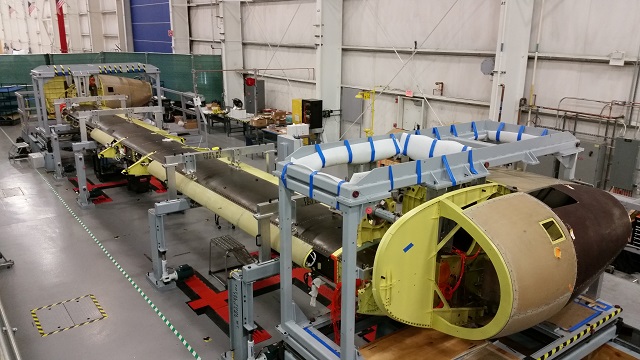Bell Helicopter’s third-generation tiltrotor, the V-280 Valor, is literally coming together in Amarillo, Texas, as the company enters the final stages of mating the wing with the fuselage.
It’s a moment of truth for the engineers and fabricators who have been working on prototype aircraft, which is being prepared to fly in September 2017 as part of the US Army’s Joint-MultiRole Technology Demonstrator (JMR-TD) programme. If one part or structure doesn’t line up the project might stall, but Vince Tobin, Bell’s vice-president of V-280 and Future Vertical Lift says the company’s three-dimensional design models have proven accurate so far.
“We have every confidence that it will work,” Tobin tells Flightglobal. “It’s a major risk reduction in the way we look at it with things going forward. Beyond just the components fitting together, we’ve used this to make sure there’s no conflict with the tooling.”


V-280 wing and fuselage come together in Amarillo, Texas, ready for mating
Bell Helicopter
The mating of the wing comes five months after Spirit AeroSystems delivered the V-280 fuselage from its plant in Wichita, Kansas. The two nacelles, built by Israel Aerospace Industries, were mated with the wing last month, says Tobin. The entire structure should come together by the end of the week.
The V-280 is Bell’s attempt to bring the US Army back around to tiltrotor design after it abandoned the V-22 Osprey programme in favour of trusted Vietnam War-era utility helicopters, like the Sikorsky UH-60 Black Hawk and Boeing CH-47 Chinook.
The Osprey, designed in the 1980s, is the first tiltrotor to enter operational service, having been purchased by the Marine Corps, Air Force Special Operations Command and soon the Navy for a wide variety of missions. The Army, though, prefers side doors on its multi-role helicopters, which cannot be engineered into the V-22 because of its tilting engines and main support beam.
The V-280, however, tilts its rotors and not the entire engine as it transitions from hover to forward flight and the main support beam runs over the roof of the cabin instead.
“One of the first design questions we had to wrestle with for a medium-lift rotorcraft targeted for the US Army is, do we go with the ramp like the V-22 or side doors that the army has been operating out of for the medium-lift aircraft since the 1960s?” explains Tobin. “When the troops egress out of the side doors, they have the problem of engines in their way and can’t fire out the side of the aircraft. That forced us to go to the fixed nacelle configuration.”

Bell Helicopter
The hot, down-facing turbine exhaust also complicates where the V-22 can land. V-280 doesn’t have that problem, and it also does away with the V-22’s forward-swept dihedral wing in favour of a flat, straight wing. That greatly reduces the aircraft’s complexity by eliminating the mid-wing gearbox, thereby lowering the manufacturing cost.
“There’s no dihedral, no anhedral and no sweep in the wing,” says Tobin. “In the V-22, the forward sweep is there because 30 years ago when we were doing the design, we didn’t really know how far the rotors were going to flap back toward the wing in forward flight. What we’ve determined over years of experience with the V-22 is that the flapping is pretty insignificant; it’s on the order of a degree or two.”

Sikorsky-Boeing SB-1 Defiant
Sikorsky
The V-280 is Bell's answer to the US Army's requirement for a mid-sized next-generation rotorcraft with twice the speed and range of a conventional helicopter to replace the Block Hawk and Boeing AH-64 Apache gunship in the 2030s. It's competing against the Sikorsky-Boeing SB-1 Defiant – a rigid-rotor, compound coaxial pusher prop type based on Sikorsky's X-2 and S-97 demonstrators.
Tobin hopes that both types will fly next September so that the army can quickly determine which of the two is best and proceed with an acquisition.
The V-280 has a top speed of 280kt (518km/h) and range of 500-800nm. The prototype is powered by two General Electric T64 turboshaft engines, which are currently undergoing testing.
Tobin expects to begin ground runs in 12 months ahead of first flight next September. The JMR flight campaign runs through 2019.



Bell Helicopter
Source: FlightGlobal.com
















